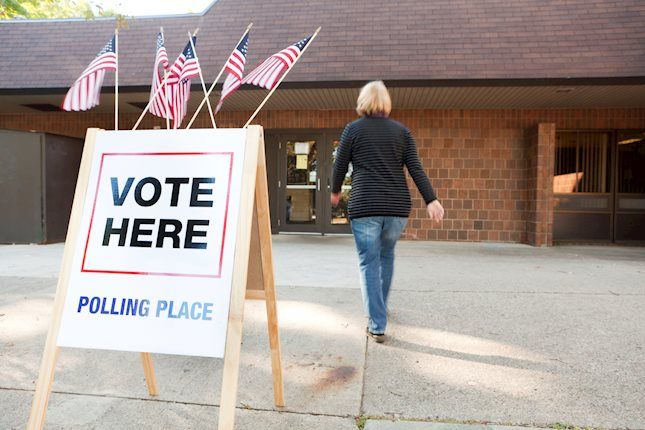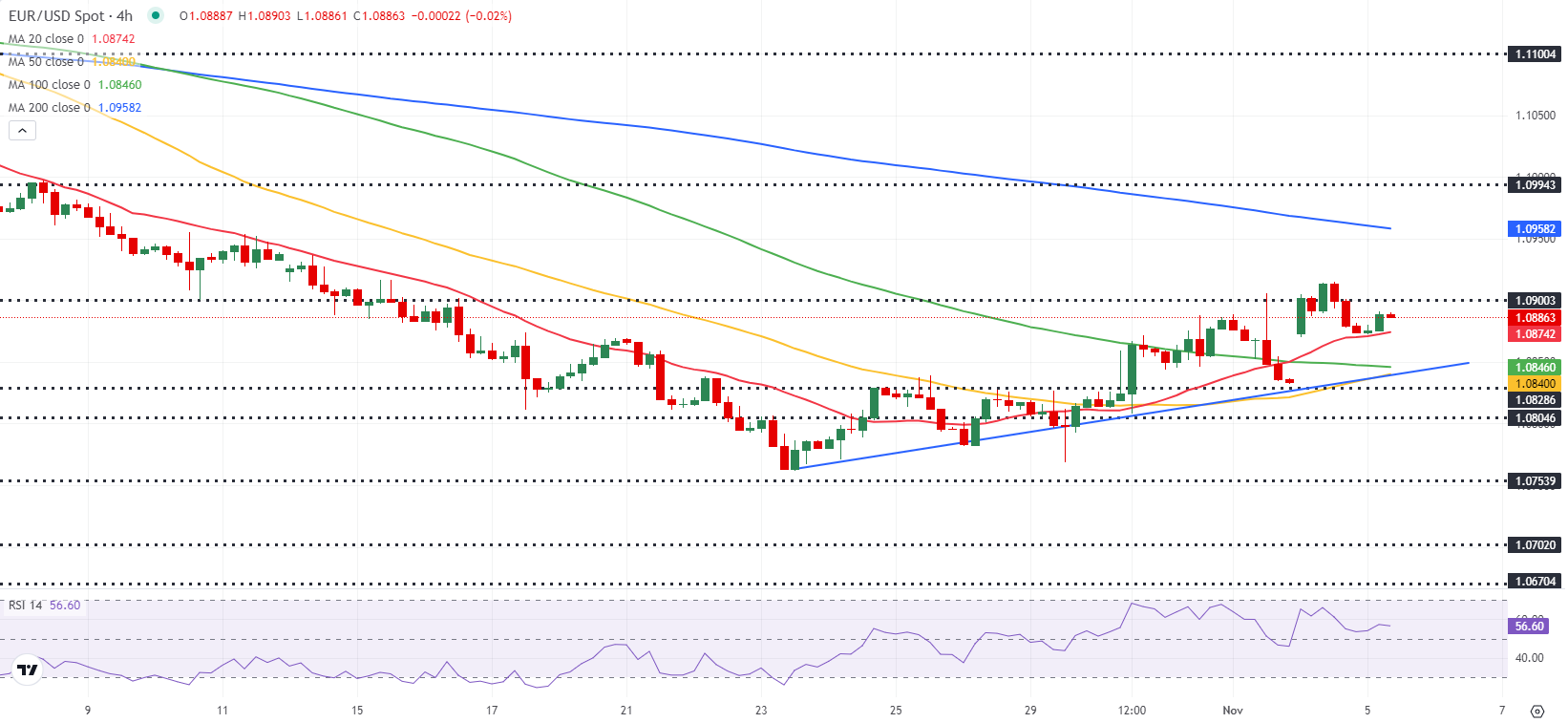- EUR/USD fluctuates in a narrow range below 1.0900 on Tuesday.
- Markets turn anxious on the day of the US presidential election.
- The pair could come under renewed bearish pressure if 1.0870 support fails.
After opening the week with a big bullish gap, EUR/USD climbed above 1.0900 but lost its traction later in the American session on Monday. The pair fluctuates in a narrow channel below 1.0900 in the European morning on Tuesday as investors move to the sidelines on the day of the US presidential election.
The selling pressure surrounding the US Dollar fuelled EUR/USD's rally on Monday. In the second half of the day, however, safe-haven flows dominated the action in financial markets and caused the pair to retreat.
The US economic calendar will feature the ISM Services PMI report for October. Nevertheless, market participants are unlikely to take large positions based on this data and await the outcome of the US election, which remains a very tight race according to the latest polls.
The TIPP poll has Donald Trump and Kamala Harris tied at 48 points in nationwide, the Ipsos poll has Harris leading by two points, 50 vs 48, and the Atlas Intel poll has Trump leading by one, 50 vs 49, as per RealClearPolling. In some swing states, such as Arizona and North Carolina, Trump seems to be holding on to a marginal lead, while Harris seems to have closed the gap in others, such as Georgia, Nevada and Pennsylvania.
If the vote count in those swing states remain close, it might be a few days before a winner is called.
EUR/USD Technical Analysis
The Relative Strength Index (RSI) indicator on the 4-hour chart stays above 50 and EUR/USD trades above the 200-day Simple Moving Average (SMA), currently located at 1.0870, reflecting sellers' hesitancy.
EUR/USD could face interim resistance at 1.0900 (round level). Once the pair clears this level, it could target 1.0950 (100-day SMA) and 1.1000 (round level, static level, 50-day SMA) next. On the downside, On the downside, a daily close below 1.0870 could open the door for an extended slide toward 1.0800 (round level, static level).
Euro FAQs
The Euro is the currency for the 19 European Union countries that belong to the Eurozone. It is the second most heavily traded currency in the world behind the US Dollar. In 2022, it accounted for 31% of all foreign exchange transactions, with an average daily turnover of over $2.2 trillion a day. EUR/USD is the most heavily traded currency pair in the world, accounting for an estimated 30% off all transactions, followed by EUR/JPY (4%), EUR/GBP (3%) and EUR/AUD (2%).
The European Central Bank (ECB) in Frankfurt, Germany, is the reserve bank for the Eurozone. The ECB sets interest rates and manages monetary policy. The ECB’s primary mandate is to maintain price stability, which means either controlling inflation or stimulating growth. Its primary tool is the raising or lowering of interest rates. Relatively high interest rates – or the expectation of higher rates – will usually benefit the Euro and vice versa. The ECB Governing Council makes monetary policy decisions at meetings held eight times a year. Decisions are made by heads of the Eurozone national banks and six permanent members, including the President of the ECB, Christine Lagarde.
Eurozone inflation data, measured by the Harmonized Index of Consumer Prices (HICP), is an important econometric for the Euro. If inflation rises more than expected, especially if above the ECB’s 2% target, it obliges the ECB to raise interest rates to bring it back under control. Relatively high interest rates compared to its counterparts will usually benefit the Euro, as it makes the region more attractive as a place for global investors to park their money.
Data releases gauge the health of the economy and can impact on the Euro. Indicators such as GDP, Manufacturing and Services PMIs, employment, and consumer sentiment surveys can all influence the direction of the single currency. A strong economy is good for the Euro. Not only does it attract more foreign investment but it may encourage the ECB to put up interest rates, which will directly strengthen the Euro. Otherwise, if economic data is weak, the Euro is likely to fall. Economic data for the four largest economies in the euro area (Germany, France, Italy and Spain) are especially significant, as they account for 75% of the Eurozone’s economy.
Another significant data release for the Euro is the Trade Balance. This indicator measures the difference between what a country earns from its exports and what it spends on imports over a given period. If a country produces highly sought after exports then its currency will gain in value purely from the extra demand created from foreign buyers seeking to purchase these goods. Therefore, a positive net Trade Balance strengthens a currency and vice versa for a negative balance.
Information on these pages contains forward-looking statements that involve risks and uncertainties. Markets and instruments profiled on this page are for informational purposes only and should not in any way come across as a recommendation to buy or sell in these assets. You should do your own thorough research before making any investment decisions. FXStreet does not in any way guarantee that this information is free from mistakes, errors, or material misstatements. It also does not guarantee that this information is of a timely nature. Investing in Open Markets involves a great deal of risk, including the loss of all or a portion of your investment, as well as emotional distress. All risks, losses and costs associated with investing, including total loss of principal, are your responsibility. The views and opinions expressed in this article are those of the authors and do not necessarily reflect the official policy or position of FXStreet nor its advertisers. The author will not be held responsible for information that is found at the end of links posted on this page.
If not otherwise explicitly mentioned in the body of the article, at the time of writing, the author has no position in any stock mentioned in this article and no business relationship with any company mentioned. The author has not received compensation for writing this article, other than from FXStreet.
FXStreet and the author do not provide personalized recommendations. The author makes no representations as to the accuracy, completeness, or suitability of this information. FXStreet and the author will not be liable for any errors, omissions or any losses, injuries or damages arising from this information and its display or use. Errors and omissions excepted.
The author and FXStreet are not registered investment advisors and nothing in this article is intended to be investment advice.
Recommended Content
Editors’ Picks

EUR/USD trades sideways near 1.0900 amid cautious optimism
EUR/USD trades sideways near 1.0900 on Tuesday. The US Dollar looks to stabilize amid cautious optimism, as uncertainty over the US presidential election outcome lingers. US ISM Services PMI is also in focus, as Americans head to the polls.

GBP/USD clings to modest gains below 1.3000, awaits US election result
GBP/USD trades marginally higher on the day but remains below 1.3000 after finding support near 1.2950 on a broadly subdued US Dollar. Traders eagerly await the outcome of the US presidential election, refraining from placing fresh bets on the major.

Gold holds steady below $2,750 as markets gear up for US election
Gold attracts dip-buyers after touching a one-week low on Tuesday and trades above $2,740. XAU/USD draws support from a combination of factors. Fed rate cut bets, declining US bond yields and subdued USD demand continue to act as a tailwind for the precious metal.

Crypto markets brace for volatility in tight race between Trump and Harris
The US presidential election is one of the most significant events in the world. Due to the influence of the country’s political decisions, policies, and economic approaches, it can significantly impact crypto and global markets.

US presidential election outcome: What could it mean for the US Dollar? Premium
The US Dollar has regained lost momentum against its six major rivals at the beginning of the final quarter of 2024, as tensions mount ahead of the highly anticipated United States Presidential election due on November 5.

Best Forex Brokers with Low Spreads
VERIFIED Low spreads are crucial for reducing trading costs. Explore top Forex brokers offering competitive spreads and high leverage. Compare options for EUR/USD, GBP/USD, USD/JPY, and Gold.

